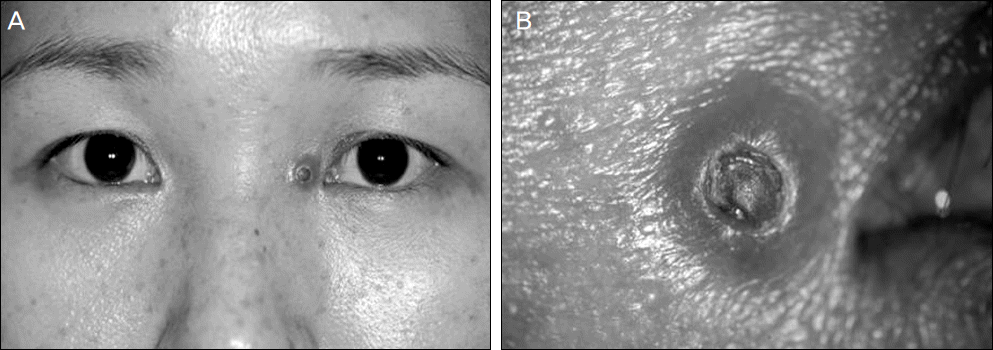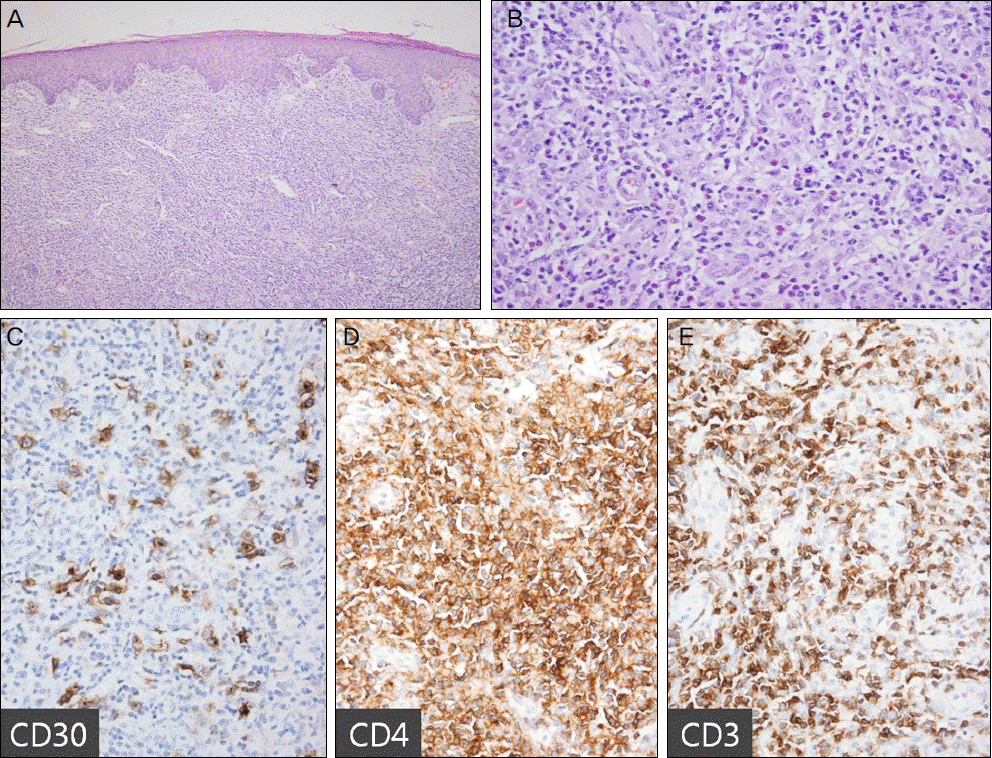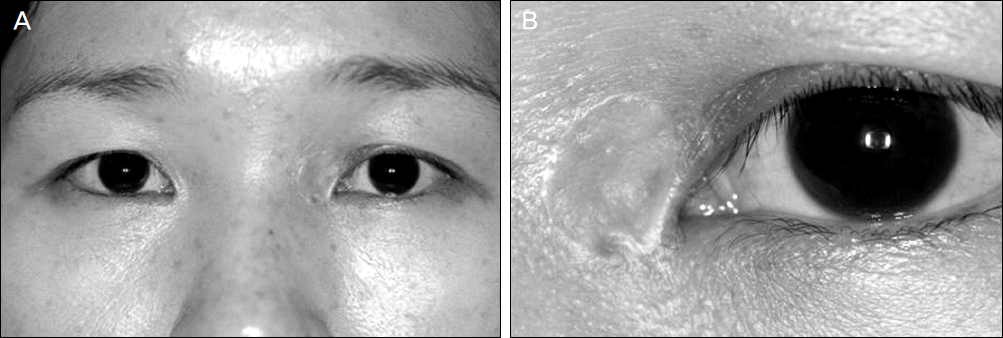Abstract
Purpose
Lymphomatoid papulosis (LyP) is one of the primary cutaneous CD30-positive lymphoproliferative disorders. LyP of the eyelid has rarely been reported. Herein, a case of typical LyP of the medial canthal area is reported. In addition, a literature review was performed.
Case summary
A 40-year-old female presented with a skin mass in the medial canthal area of the left eye that developed 2 months earlier. Initially, a focal skin lesion developed, and even with conservative treatment at a local clinic, progressed to a mass lesion having a central ulceration and adjacent edema. After 6 weeks, the adjacent edema had gradually decreased. On ophthalmic examination, the left medial canthal lesion was a 6 × 6 mm sized elevated mass with a central crater covered by crust. The clinical impression was keratoacanthoma. The lesion was widely excised and reconstructed by a full-thickness skin graft after an incisional biopsy. Histopathologic findings showed dermal infiltration of various inflammatory cells with atypical lymphocytes showing positivity to the CD30 antigen, and LyP was diagnosed. Systemic evaluation showed no evidence of systemic lymphoma and the patient has remained free of recurrence or systemic disease after a 1-year follow-up.
J Korean Ophthalmol Soc 2013;54(4):645-650
References
1. Macaulay WL. Lymphomatoid papulosis. A continuing self-healing eruption, clinically benignhistologically malignant. Arch Dermatol. 1968; 97:23–30.

2. Willemze R, Jaffe ES, Burg G, et al. WHO-EORTC classification for cutaneous lymphomas. Blood. 2005; 105:3768–85.

3. Kempf W, Sander CA. Classification of cutaneous lymphomas - an update. Histopathology. 2010; 56:57–70.

4. Calzado-Villarreal L, Polo-Rodríguez I, Ortiz-Romero PL. [Primary cutaneous CD30+ lymphoproliferative disorders]. Actas Dermosifiliogr. 2010; 101:119–28.

5. Sanka RK, Eagle RC Jr, Wojno TH, et al. Spectrum of CD30+ lymphoid proliferations in the eyelid lymphomatoid papulosis, cutaneous anaplastic large cell lymphoma, and anaplastic large cell lymphoma. Ophthalmology. 2010; 117:343–51.
6. Diamantidis MD, Myrou AD. Perils and pitfalls regarding differential diagnosis and treatment of primary cutaneous anaplastic large-cell lymphoma. ScientificWorldJournal. 2011; 11:1048–55.

7. Lee SH, Lew H, Shim JY. A case of primary cuteaneous CD30-positive lymphoproliferative disorder of the eyelid. J Korean Ophthalmol Soc. 2005; 46:1222–7.
8. Coupland SE, Krause L, Delecluse HJ, et al. Lymphoproliferative lesions of the ocular adnexa. Analysis of 112 cases. Ophthalmology. 1998; 105:1430–41.

10. Mencía-Gutiérrez E, Gutiérrez-Díaz E, Salamanca J, MartínezGonzález MA. Cutaneous presentation on the eyelid of primary, systemic, CD30+, anaplastic lymphoma kinase (ALK)-negative, anaplastic large-cell lymphoma (ALCL). Int J Dermatol. 2006; 45:766–9.

11. Clarke B, Legodi E, Chrystal V, Govender D. Systemic anaplastic large cell lymphoma presenting with conjunctival involvement. Arch Ophthalmol. 2003; 121:568–70.

12. DeCoteau JF, Butmarc JR, Kinney MC, Kadin ME. The t(2;5) chromosomal translocation is not a common feature of primary cutaneous CD30+ lymphoproliferative disorders: comparison with anaplastic large-cell lymphoma of nodal origin. Blood. 1996; 87:3437–41.
13. Winhoven SM, Murugesan S, Coulson IH. Solitary CD30+ ana-plastic large cell lymphoma of the eyelid showing regression. Br J Ophthalmol. 2005; 89:385.

14. Ramaesh K, Monaghan H, Kemmett D, et al. Retinal vein occlusion in lymphomatoid papulosis. Eur J Ophthalmol. 2002; 12:542–6.

15. Hu FR, Lin JC, Chiang IP, Yeh KH. T-cell malignant lymphoma with conjunctival involvement. Am J Ophthalmol. 1998; 125:717–9.

16. Segal ZI, Cohen I, Szvalb S, et al. Solitary extranodal anaplastic large cell lymphoma, Ki-1+, of the eyelid. Am J Ophthalmol. 1997; 124:105–7.

17. Koreen IV, Cho RI, Frueh BR, Elner VM. Primary cutaneous ana-plastic large cell lymphoma of the medial canthus and orbit. Ophthal Plast Reconstr Surg. 2009; 25:63–5.

18. Lemagne JM, Croughs P, Roumanos N, Maldague P. [Lymphomatoid papulosis of the eyelid]. J Fr Ophtalmol. 1987; 10:247–52.
19. Boulton JE, Chesterton JR, McGibbon DH. Symmetrical lymphomatoid papulosis masquerading as pyoderma chancriformis of the eyelids. Br J Ophthalmol. 1995; 79:391–2.

20. Kempf W. CD30+ lymphoproliferative disorders: histopathology, differential diagnosis, new variants, and simulators. J Cutan Pathol. 2006; 33:58–70.

21. Droc C, Cualing HD, Kadin ME. Need for an improved molecular/genetic classification for CD30+ lymphomas involving the skin. Cancer Control. 2007; 14:124–32.

22. Yip L, Darling S, Orchard D. Lymphomatoid papulosis in children: experience of five cases and the treatment efficacy of methotrexate. Australas J Dermatol. 2011; 52:279–83.

23. Kempf W, Pfaltz K, Vermeer MH, et al. EORTC, ISCL, and USCLC consensus recommendations for the treatment of primary cutaneous CD30-positive lymphoproliferative disorders: lymphomatoid papulosis and primary cutaneous anaplastic large-cell lymphoma. Blood. 2011; 118:4024–35.

24. Kadin ME. Current management of primary cutaneous CD30+ T-cell lymphoproliferative disorders. Oncology (Williston Park). 2009; 23:1158–64.
Figure 1.
(A) An 6 × 6 mm sized dome shaped nodule with central crater covered by crust was observed in the left me-dial canthal area. (B) This lesion was thought to be a keratoacanthoma at first visit in our clinic.

Figure 2.
(A) The histopathological finding shows perivascular and dense dermal infiltration of inflammatory cells and some large atypical lymphocytes (H&E, ×;200). (B) High magnification shows large atypical lymphocytes with prom inent nucleoli forming an infiltrate in lymphomatoid papulosis (H&E, ×;400). (C-E) On immunohistochemical stains, the dermal infiltrates are composed of lymphocytes expressing CD 30, CD4 and CD 3 positive cells (×;400).





 PDF
PDF ePub
ePub Citation
Citation Print
Print



 XML Download
XML Download